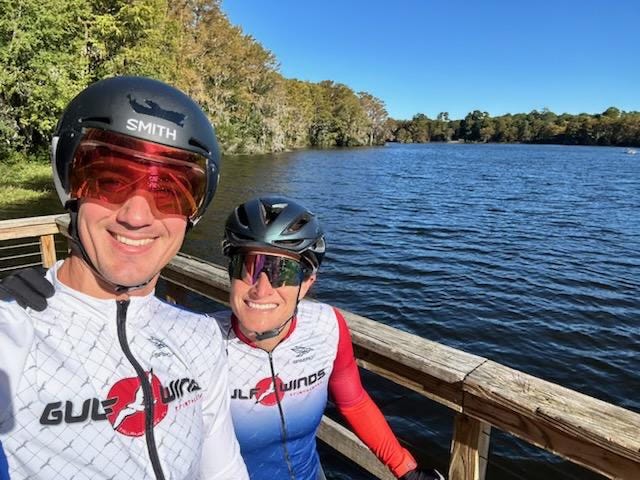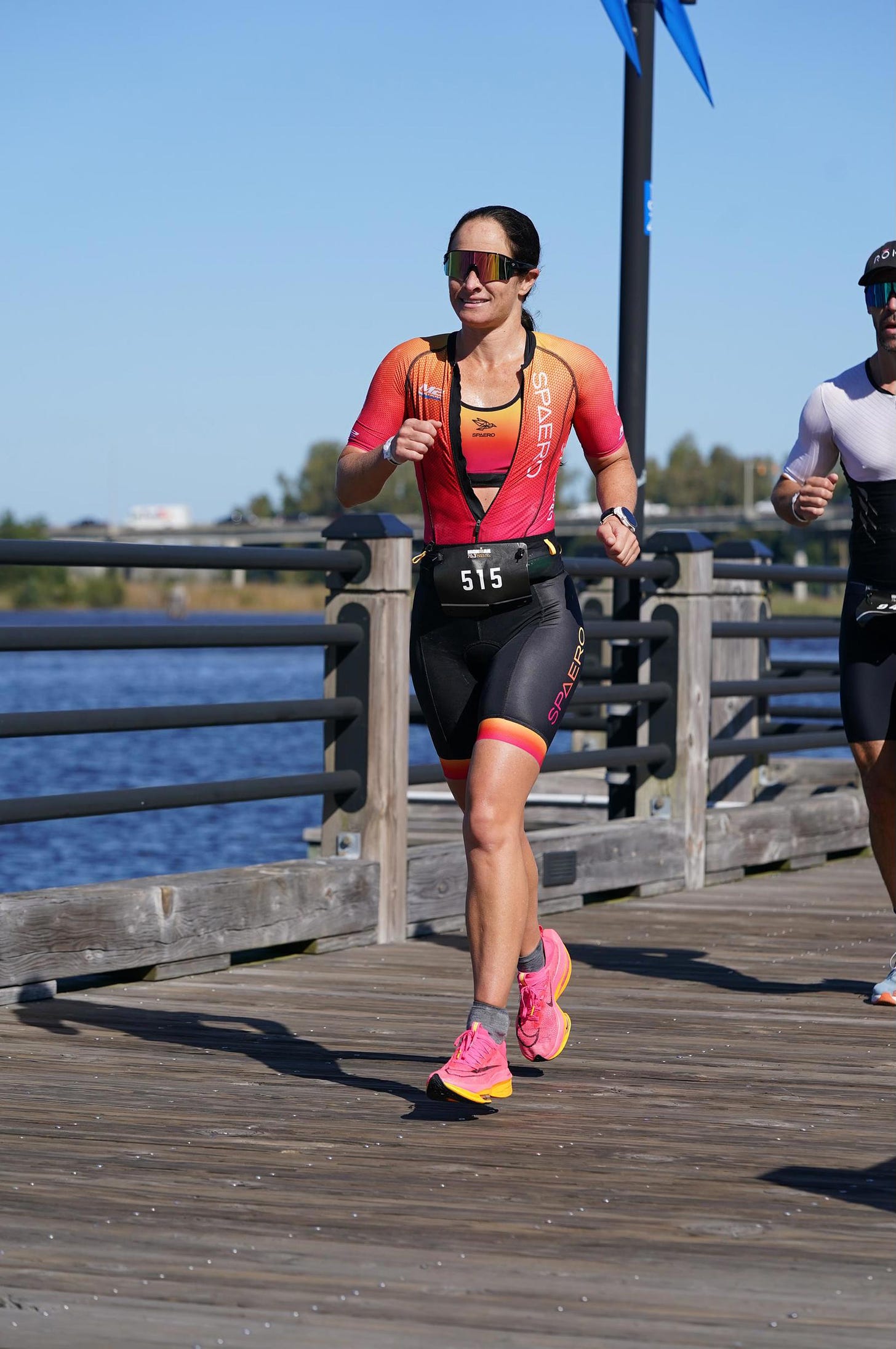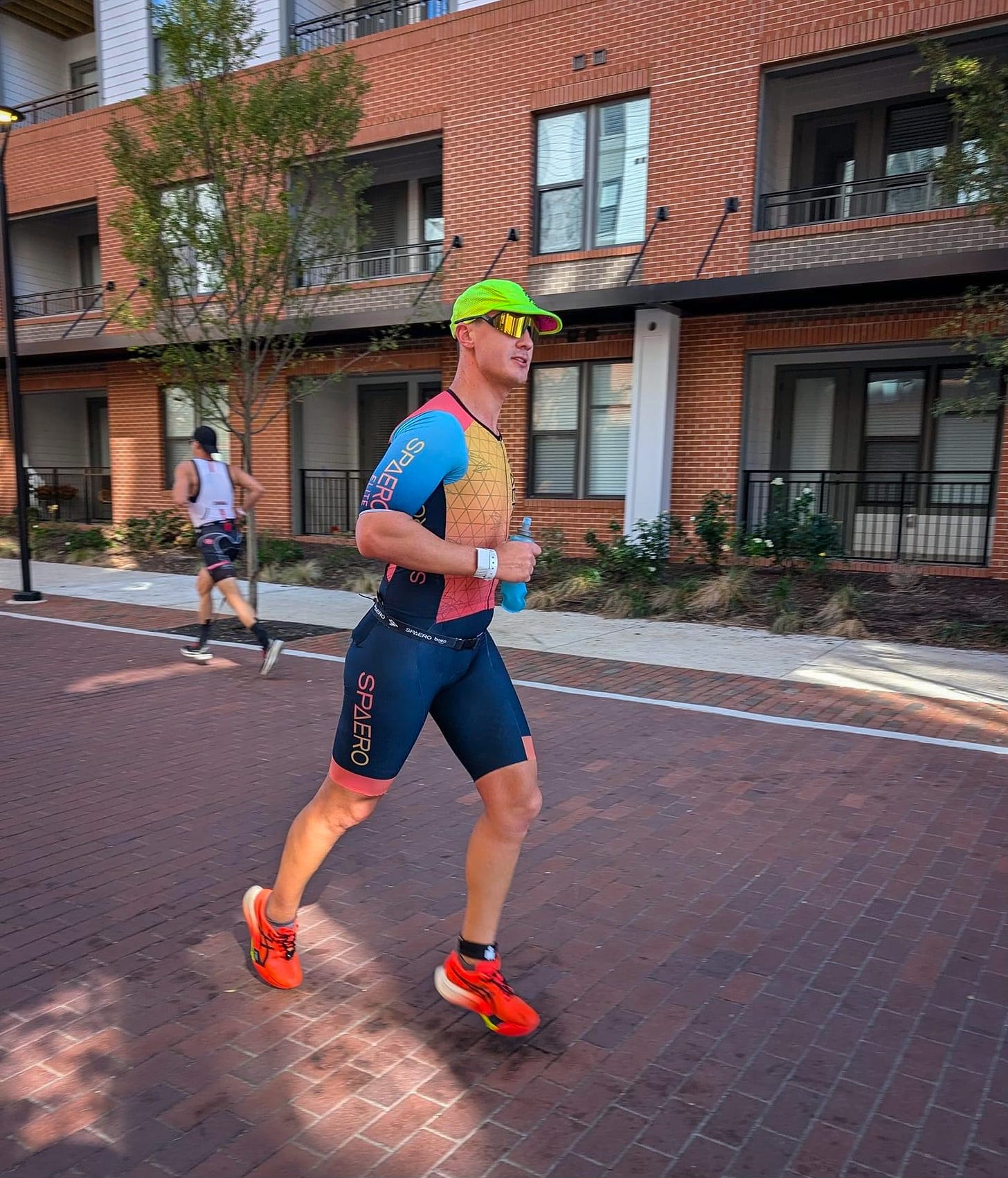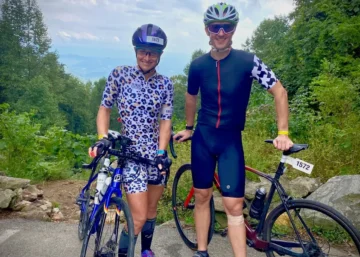
I’m not big on writing race reports.
I know, I know. But that’s what the title says!
It just feels a bit self-serving to talk about myself for an entire post, detailing the minutia of my race. (I mean you don’t really want to know my carb intake or bike power stats, do you?)
However, the more I thought about it (while on my run this morning) I’ve realized that a race report can go beyond simply recounting an event.
Most of us learn best through real-world experiences. A race report is a first-hand account of what went right and what went wrong. By reading about preparation, strategy, and execution, you can learn from someone’s else’s experience and apply those lesson to your own training and racing.
So that’s what we’re doing today!
What follows is a race report from the 2024 North Carolina 70.3 triathlon with insights and takeaways you can use to improve your performance at your next half Ironman. (or any distance triathlon, really).
Included is:
- First-hand account of the race from the perspective of two different athletes (Matt + BB)
- Detailed look at our race preparation and strategy.
- Course specific insights for athletes looking to do this race in the future.
- Explanation of what racing a 70.3 is really like (not the glorified marketed version) so you can prepare mentally for the ups and downs of race day.
- EXCLUSIVE for Triple Threat Life Club members- How to use a 70.3 to build for a 140.6.

On Saturday, Matt and I competed at North Carolina 70.3 in Wilmington. It’s one of our favorite races! We actually did this race the week before our wedding in 2022. (Mom was totally freaking out).
This 70.3 is a great choice for two different types of triathletes: first-timers and those looking for a PR (personal record). Due to the nature of the course: fast swim with a downstream current, flat bike, and flat run, it’s a great option for those looking to do their first half-Ironman. This also means it’s a course for PR-seekers. Just scroll through Instagram this week and you’ll see almost everyone listing a shiny, new PR by big margins.
However, there are a few quirks that make this race a bit different than other 70.3 triathlons. The big one is that it’s a split transition race, where T1 and T2 are located in different places, commonly referred to as a point-to-point race.
It might sound intimidating, but a split-transition race is actually very easy once you get the hang of it.

How to do a Triathlon With Split Transitions
Another big benefit is the weather. It’s traditionally cool and less humid, which sets you up well for success if you’ve been training in the heat all summer.
Because this race is so popular, with first-timers and seasoned athletes alike, it can get a bit busy on the bike course. So there’s a few things you need to know about swim seeding and drafting in order to set yourself up for success.

Pre-Race Prep
Since the race was on a Saturday (most 70.3 are on a Sunday) that backed up our timeline by one day. This meant we left town Wednesday morning to make the 9-hour drive from Florida to North Carolina.
Travel day ends up being a wash as far as training, because that provides enough stress on its own, but for this particular race we did a swim workout before we started the drive.
The focus for Thursday was to get in a short bike ride and run off the bike to check our equipment and make sure our bike computer, heart rate strap, and cadence sensors were synced and working properly.
We chose to ride on the run course because it’s in a secluded area around a lake, so less traffic. Getting there from downtown was not a fun ride across the cobblestones… so I’d suggest driving out there and doing laps on the run course.
Then, we headed to athlete check-in. TIP: You need your QR code and ID to pick up your athlete wristband and race packet. More about this process in detail below.

The Ironman and 70.3 Playbook: How to Navigate Race Week, Transition, and More
After athlete check-in, it was time to put our feet up and relax. We’ve made a mistake in the past- walking around town and enjoying the sights. But logging 20,000 steps 48 hours before a race is a bad idea. Trust me.
Also, what you eat 48 hours before the race is very important. I’ve learned this the hard way. Now, I prioritize carbs, a little protein, and avoid fat, spicy food, vegetables, and high fiber, anything that might upset my stomach on race day.
My favorite pre-race dinner is baked chicken with mashed potatoes and a slice of bread. My go-to race morning breakfast is a bagel with butter and a banana. Matt needs more protein, so he adds three eggs to this meal and an energy drink.
An interesting part about NC 70.3 is that the swim start is located in a different area than the finish line. Therefore, you use shuttles to get out to the beach. Because we were staying downtown, we woke up at 3:45 am to get to the first shuttle at T2 that would take us to T1 so we could put our bottles on our bikes and pump up tires, ect.
Then, we had to take a second shuttle to get to the swim start. This means an early morning, but staying near the finish line instead of the beach meant we could finish the race, take a quick shower, and then cheer on our friends. Another option is to stay at the beach, park downtown the night before, then Uber back so your car is waiting near the finish line.

North Carolina 70.3 Swim
The swim start was cold- low 40s. In hindsight, we should’ve brought some throwaway socks or sandals because my feet were pretty frozen from standing on the concrete. While waiting for the swim start, we get off our feet and relax. Once it gets about 30 min. before the start, we use the bathroom, put on our wetsuits, and have an energy gel 15 min. out.
I wore my new ROKA Maverick X3, which is pretty amazing. I have a review post coming out next week, so stay tuned. It’s fancy…
Because this bike course gets crowded, we lined up with the 25 min. and under swimmers. Are we swimming that fast typically? Ah, no. But, it’s part of a strategy that sets us up well for the bike. (FYI, we both did around 28:30).
TIP: In a race that offers swim seeding, be generous and line up as soon as reasonably possible. Waiting an hour to start the swim only puts you out later on the bike course when it’s more congested and later on the run course in the heat of the day.

The current that morning was ripping, but there was also a lot of chop because it was windy. There’s always a bit of congestion around the turn buoys, and Matt got caught up in some of it. Remember, you don’t have to swim right on top of the buoys. They’re just guidelines. Steer clear of the craziness. If you get too far off course, a volunteer kayaker will let you know.
Matt and I have different strategies for the swim. He likes to start easy and build into his effort to avoid any open water anxiety. I start a bit faster and then ease off once I clear the big pack of swimmers at the start. It takes me a bit longer to warm up and get into a rhythm, then I can push the last 1/3 of the swim.
Matt stopped at the wetsuit strippers, but I kept my wetsuit on into transition.(As mentioned previously, it was freaking cold.) Since we came out of the swim together, we were in transition at the same time, which is always a favorite part of the race!

North Carolina 70.3 Bike
We both made the decision not to add any extra kit for the bike ride. Yes, you can wear arm warmers, vest, pants, or gloves, but you have to think about how long you’re actually going to want to wear it and where you will put it when you take it off.
After 10 minutes into the bike, we both warmed up just fine. In hindsight, the only thing I would’ve used were gloves and maybe toe-covers, because my fingers and toes tend to stay frozen and it’s hard to grip water bottles. (with my fingers, not my toes, I’m not that weird).
There’s always a bit of traffic to negotiate at the start of the bike, but I was able to get into my pace rather quickly and it felt sustainable. I was SO excited about this, because my legs felt better than they have ever during a 70.3. I think the difference was a bit more mileage during race week. It just works better for me so I avoid feeling dull.

Steal Our Pre-Race Prep Strategy
This bike course isn’t the most scenic, so I was very proud that I stayed focused the whole time and didn’t let my mind wander. I can be like a squirrel with ADHD on the race course, so I was very cognizant about periodically cycling through all my metrics: how’s my RPE, heart rate, cadence, power, nutrition?
Matt encountered a bit more traffic on the course than I did, and he got caught up with long packs of drafting athletes. This has happened to me in the past, and it’s incredibly frustrating, because it’s hard for a single athlete to overtake a long line.
There’s not much you can do about it except for manage your own effort and ignore those who choose to break the rules. He said he did unfortunately push it a bit too hard at the start trying to break away from the groups so he wouldn’t get a penalty.
Next week we’re going to delve more into the topic of drafting during triathlons with Drafting 101, which will include an explanation of the rules and tips on what not do from an Ironman referee!
The first 30 miles was a headwind, but it honestly didn’t bother me much, and the 10 mile tailwind headed back into town was amazing.
Besides having different paces and heart rate ranges to work with, Matt and I also have different nutrition strategies. I’m not going to outline it exactly, but on the whole Matt takes 90g of carbs an hour, while I’m closer to 60g of carbs. He also likes to use a gel or two, while I get all my carbs from liquid. How we’re similar is that we both add electrolytes directly to our carb bottles, and we use the same product- Never Second. We only stop at aid stations for extra water.
TIP: When it’s cold, you tend not to drink as much. I didn’t make it through my planned 3 bottles, only 2 1/2, so if your carbs are in liquid, like us, you have to make up the deficit some other way. That’s when a gel might be useful.

How to Navigate Triathlon Aid Stations Like a Pro

North Carolina 70.3 Run
Once we got to the run, it had warmed up considerably. The course was a bit different than in previous years, because the finish line was in a different place. Therefore, there were a few hills in the first two miles.
The importance of starting the first few miles running off the bike can’t be overstated, but despite knowing this, both Matt and I probably started off a bit hot. By that I mean, a bit too close to our respective race paces, which came back to bite both of us in the end a little.
The first 8 miles for both of us was amazing. I felt stellar, my goal pace was easy, it felt sustainable, and I was actually having fun. Same thing on Matt’s end.
The run course at NC 70.3 is an out and back with the turnaround at mile 7. Heading out is a bit up in elevation, while heading back into town is a bit down, but it’s still considered “flat.” Most of the run course takes place on a shaded section around a lake, and they have the most spectacular aid stations. My favorite is Sunshine-ville with happy volunteers and music!

Run nutrition is where Matt and I differ dramatically. He has a soft flask that can hold 4 gels. He takes those throughout the race and supplements with water at aid stations. I need to drink more than that, so I have a race belt that can carry two small flasks. I carry extra powder to refill with water at aid stations. We practice this before the race so I can do it fast.
By mile 8, both of us felt lacking in energy and pace slowly declined the last 5 miles. Now this isn’t entirely unexpected since we have an Ironman in 3 1/2 weeks and have been training for that… But it’s annoying nonetheless.
When I get to that point in a race when things aren’t going exactly like I’d hoped, here’s what I do.
- Focus on form– I shorten my steps underneath me, focus on quick cadence, and run in a solid, tight, package, not all loose goosey with everything flailing about.
- Regulate breathing– When you get tired, you start to gasp. When I notice this, I become very intentional about my breathing. So, 2 shorter inhales and one longer exhale.
- Bring the pace back– Sometimes you have to back it off and hold on to a pace that’s sustainable. Towards the end, I knew my pace wasn’t where I wanted, so I stopped looking at my watch and tried to hold on to where I was so it didn’t drop off any further. This might also mean walking an aid station or two. (Matt and I both did that at this race, which we typically don’t do during a 70.3, but it was necessary on the day).
- Talk to yourself– Yes, sounds crazy. Does it work? Absolutely. Telling yourself you’re running like sh*t isn’t going to help you run any faster. (unless you’re a masochist) But saying something more instructive might. A few phrases I used on this run. “Just hold it together.” “Deep breaths.” “Pick up your feet.”
Unlike most athletes, my favorite part of the race is not running down the red carpet to the finish line. Since Matt finishes about 40 minutes ahead of me, he always runs back out on course to meet me. As soon as I see him, I know I’m right there.
That’s love.
Click here to learn how and why to write a race report. We do it after every race.

Highs, Lows, and Buffaloes
Today’s EXCLUSIVE for Triple Threat Life Club members is- How to Use a 70.3 to Build to a 140.6. We’ve got insight from triathlon coach, Mark Saroni, and professional triathlete, Hayley Chura.
Visit Triple Threat Life on Substack to sign up for the free newsletter.


